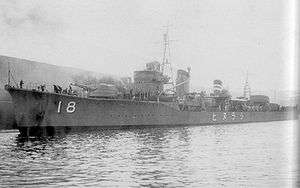Action of 5 July 1942
| Action of 5 July 1942 | |||||||
|---|---|---|---|---|---|---|---|
| Part of the American theater and the Pacific theater of World War II | |||||||
 USS Growler | |||||||
| |||||||
| Belligerents | |||||||
|
|
| ||||||
| Commanders and leaders | |||||||
|
| unknown | ||||||
| Strength | |||||||
| 1 submarine | 3 destroyers | ||||||
| Casualties and losses | |||||||
| none |
~200 killed or wounded 1 destroyer sunk 2 destroyers damaged | ||||||
The Action of 5 July 1942 was a naval engagement fought during the Aleutian Islands Campaign of World War II. During the action, the American submarine USS Growler attacked three Japanese warships anchored off Kiska island. It was the first action of Growler's career and ended with the loss of dozens of Japanese sailors.
Background
Over the course of the Pacific War, Growler—under various commanders—sank 17 enemy vessels, including many armed ships. She was a Gato-class submarine and had a complement of 60 officers and men. Her armament included ten 21 in (530 mm) torpedo tubes and one 3 in (76 mm)/50-caliber deck gun. On her first patrol from Pearl Harbor to Alaska, she was commanded by Lieutenant Commander Howard Gilmore. Japanese forces included the 2,490 long tons (2,530 t) Kagerō-class destroyer Shiranui with 240 crewmen and six 5 in (127 mm) guns, several anti-aircraft guns, eight large torpedo tubes and 36 depth charges. There were also the two 2,370 long tons (2,410 t) Asashio-class destroyers Arare and Kasumi, each with about 200 men and mounting the same armament as Shiranui. The three vessels were assigned to the occupation of Kiska and had participated in the Battle of Pearl Harbor.
Action

Imperial Japanese Navy and Imperial Japanese Army troops had occupied the island since 6 June 1942 and had met little resistance. The following action proved to be the deadliest encounter between the opposing forces in the Kiska area. Growler was cruising 7 mi (6.1 nmi; 11 km) east of Kiska Harbor naval base when she came across the three Japanese destroyers at anchor a fair distance away. Submerged, the submarine closed on the enemy and launched a spread of torpedoes from her six forward torpedo tubes at a position in which the enemy vessels appeared to be overlapping one another. Growler then surfaced. The Japanese were completely unaware of Lieutenant Commander Gilmore's attack, of the six torpedoes fired, at least three struck their targets.
Two of the destroyers were hit amidship almost simultaneously and were severely damaged. Just before the third destroyer was hit in the bow, it maneuvered and fired two torpedoes of her own. Growler was almost destroyed when one of the torpedoes swished by just off her port side and the other off her starboard. Both missed their target though so the Americans dived deep to avoid depth charges and escaped. Japanese forces did not continue the battle however, Arare exploded, so Shiranui moved to rescue the survivors while Kasumi was out of action. Over 200 Japanese naval personnel were killed or wounded. Of Arare's 200 man complement, only 42 men were saved by Shiranui, while the Americans sustained no damage or casualties.
Aftermath

Finding no more enemy ships in Aleutian waters, Growler returned to Hawaii and ended her first patrol. For his distinguished leadership, Howard Gilmore was promoted to the rank of commander and received the Navy Cross. Gilmore was later killed off the Philippines during the Action of 7 February 1943 when he rammed Growler into a Japanese gunboat. In a quick surface action, Commander Gilmore was wounded by machine gun fire and ordered his ship to submerge while he was still on deck. The commander became one of the seven American submariners to be awarded the Medal of Honor for duty in World War II. Growler went on the engage in nine more successful patrols in the Pacific.
Order of Battle
United States Navy
- USS Growler, submarine
Imperial Japanese Navy
See also
References
This article incorporates text from the public domain Dictionary of American Naval Fighting Ships.
- Bauer K. Jack, Roberts S. Stephen, "Register of Ships of the U.S. Navy, 1775–1990: Major Combatants." Westport, Connecticut Greenwood Press (1991) pg# 271 ISBN 0-313-26202-0